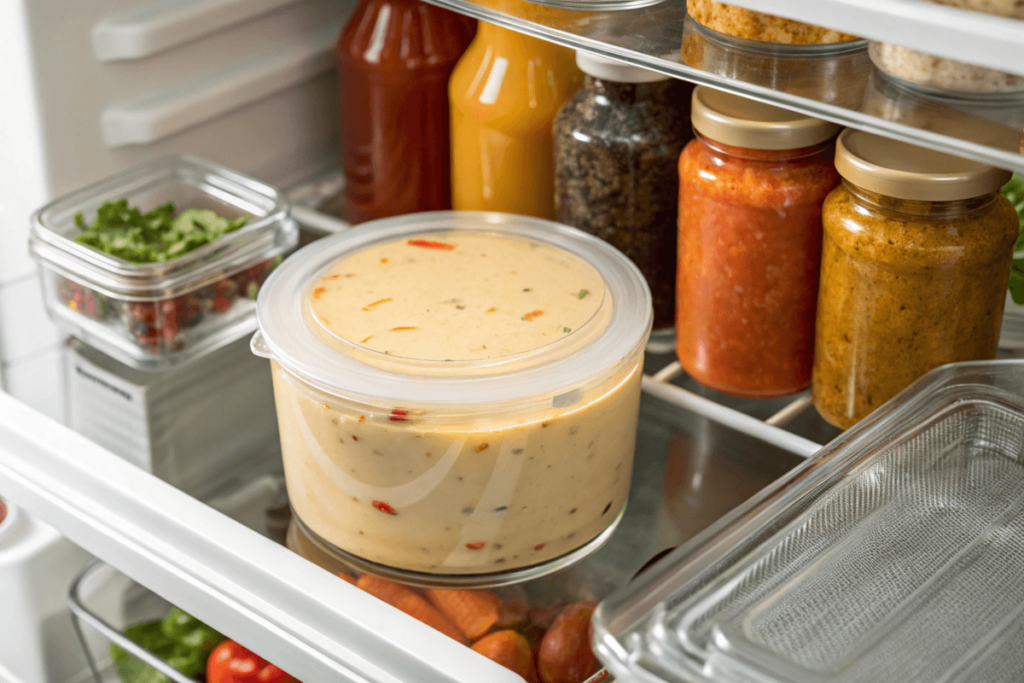Smoked queso, with its rich, smoky flavor, has become a favorite addition to parties, barbecues, and casual gatherings. But if you’ve ever found yourself wondering “How long is smoked queso good for?” you’re not alone. From storage tips to identifying spoilage, this guide will walk you through everything you need to know to make the most out of your delicious queso. We’ll discuss factors affecting its shelf life, proper storage techniques, and even health considerations. Let’s dive in and keep your queso fresh and flavorful!
Introduction to Smoked Queso and Its Popularity
What is Smoked Queso?
Smoked queso is a creamy, cheesy dip that’s infused with the rich, robust flavors of smoke. It’s typically prepared by combining melted cheeses, savory ingredients like sausage or jalapeños, and spices, all smoked on a grill or smoker. This process gives it a depth of flavor that sets it apart from traditional queso. Whether served with tortilla chips or drizzled over nachos, it’s a versatile dish that’s hard to resist.
Why Has Smoked Queso Become Popular?
This delectable dip has surged in popularity thanks to its versatility and the growing trend of outdoor cooking. With backyard smokers becoming more accessible, food enthusiasts have been experimenting with classic recipes, and smoked queso is a standout. Its bold, smoky flavor pairs perfectly with summer cookouts, game-day feasts, and potlucks.
Plus, the recipe is highly customizable! From spicy jalapeños to sweet bell peppers and savory chorizo, smoked queso can be tailored to suit individual tastes. It’s a dish that brings people together, offering a rich, indulgent treat for all.
The Role of Freshness in Queso Enjoyment
While smoked queso is undeniably delicious, its appeal diminishes when it’s past its prime. Freshness is key to enjoying the rich flavors and creamy texture of this dish. Improper storage or overextended shelf life can lead to spoilage, ruining both the flavor and safety of the queso. By understanding how long smoked queso is good for and following best practices for storage, you can make the most out of every batch.
Factors Affecting the Shelf Life of Smoked Queso
Key Ingredients and Their Impact on Shelf Life
The ingredients used in smoked queso play a huge role in determining how long it stays fresh. Dairy products like cheese and milk, which form the base of most queso recipes, are highly perishable. Additional ingredients like cooked sausage, bacon, or vegetables can also impact its longevity. For example, smoked queso containing meat might spoil faster than a vegetarian version if not stored properly.
Moreover, preservatives or additives in store-bought cheeses can sometimes extend shelf life. On the other hand, fresh, homemade options tend to spoil more quickly. Knowing what’s in your queso can help you estimate its shelf life and storage needs.

Storage Conditions: Refrigeration vs. Room Temperature
Storage is a critical factor when asking “How long is smoked queso good for?” At room temperature, smoked queso can quickly develop bacteria and spoil. The general rule of thumb is to refrigerate queso within two hours of preparation to maintain safety and flavor.
In the fridge, smoked queso typically lasts 3-5 days, provided it’s stored in an airtight container. Cooler temperatures slow bacterial growth, keeping your queso fresh for longer. Room-temperature storage, especially beyond two hours, significantly increases the risk of spoilage.
The Role of Smoking in Prolonging Shelf Life
Smoking isn’t just about flavor—it can also influence how long queso lasts. The smoking process involves cooking the queso at a low temperature, which can help reduce bacterial growth. Additionally, the natural preservatives in smoke, such as phenols and carbonyls, can extend the shelf life of smoked foods. However, this doesn’t make queso immune to spoilage. Proper storage remains essential.
How Long Smoked Queso Lasts in Various Storage Scenarios
In the Fridge: Recommended Timeframes
When stored correctly in the refrigerator, smoked queso can last up to five days. To maintain freshness, transfer the queso to a sealed, airtight container as soon as it cools. Avoid using containers that allow air exposure, as this can lead to bacterial growth and spoilage.
Make it a habit to inspect refrigerated queso before consuming it. If you notice changes in texture, smell, or appearance, it’s better to err on the side of caution and discard it.
Can You Freeze Smoked Queso? Guidelines for Freezing
Freezing is a great way to extend the life of smoked queso. When frozen, queso can last up to three months without significant loss in flavor. Use a freezer-safe container or a heavy-duty freezer bag to minimize freezer burn. Be sure to label the container with the date, so you know when it’s time to use it.
When reheating frozen queso, thaw it overnight in the refrigerator and warm it on low heat to preserve its creamy texture. Stirring frequently during reheating will help restore its original consistency.
Room Temperature Storage: Risks and Recommendations
Leaving smoked queso out for extended periods is a recipe for disaster. At room temperature, bacteria multiply rapidly, making the queso unsafe to eat within just a few hours. If you plan to serve queso at a gathering, consider using a warming tray or a slow cooker to keep it at a safe temperature.
When in doubt, follow the USDA’s “two-hour rule” for perishable foods. If smoked queso has been sitting out for more than two hours, it’s best to throw it out to avoid potential foodborne illnesses.
Signs That Smoked Queso Has Gone Bad
Visual Changes: Mold and Discoloration
One of the clearest signs that your smoked queso has spoiled is the appearance of mold or unusual discoloration. Fresh queso typically has a creamy yellow or white hue, depending on its ingredients. If you notice green, blue, or black spots, it’s a surefire sign that mold has taken over. Additionally, if the surface of the queso has become dry or crusty, it’s likely no longer safe to eat.
Pay attention to any oily separation, which can indicate the breakdown of ingredients. When in doubt, it’s better to err on the side of caution and toss it out.
Texture Alterations and Dryness
Texture is another indicator of freshness. Smoked queso should have a smooth, creamy consistency. If it becomes gritty, excessively thick, or rubbery, it’s probably past its prime. Dryness is a common issue, especially if the queso has been left uncovered or improperly stored.
Keeping smoked queso sealed in an airtight container can help maintain its texture. But once the quality deteriorates, reheating may not restore its original creaminess.
Smell and Taste Indicators
Spoiled queso often emits an off-putting smell that’s sour or rancid. Fresh queso, on the other hand, smells mild and cheesy. Trust your nose—if it doesn’t smell right, it’s best to avoid tasting it.
If you do take a small bite and it tastes sour, bitter, or just “off,” don’t take another. Consuming spoiled queso can lead to unpleasant health issues, which we’ll cover in the next section.
For more cheesy recipes and tips, check out our smoked queso recipe .
Proper Storage Techniques for Maximum Freshness
Best Practices for Refrigeration
Refrigerating smoked queso promptly is the best way to preserve its quality. Once cooled, transfer the queso into an airtight container. Glass containers or BPA-free plastic ones are ideal because they prevent air exposure and help lock in freshness.
To avoid cross-contamination, don’t use the same utensils to scoop queso after it’s been refrigerated. Always use clean spoons or ladles to serve portions. Refrigerated smoked queso is best consumed within 3-5 days for optimal taste and safety.
Safe Reheating Methods to Avoid Spoilage
Reheating smoked queso can indeed be tricky; however, with the right approach, you can maintain its creamy texture. Overheating, for instance, may cause it to separate or lose its smooth consistency. To avoid this, the best method is to warm it on low heat, either on a stovetop or in a slow cooker. Furthermore, stirring frequently will not only prevent scorching but also ensure that the dip heats evenly. Alternatively, you can use a microwave, though short intervals and regular stirring are essential to avoid ruining its texture.
Microwaving is another option but should be done in short intervals, stirring in between. This prevents overheating and keeps the cheese dip smooth.
Using Airtight Containers for Extended Shelf Life
Investing in quality airtight containers is a small but significant step to extend the shelf life of your smoked queso. These containers minimize exposure to air, which can dry out the queso and promote bacterial growth. Labels with dates are also helpful for tracking how long your queso has been stored.
By following these storage tips, you’ll get the most out of your smoked queso while ensuring it remains safe to eat.
Health Risks of Consuming Expired Smoked Queso
Potential Foodborne Illnesses
Consuming expired smoked queso can expose you to harmful bacteria like Salmonella, Listeria, and E. coli. These bacteria thrive in dairy-based products, especially if they’re stored improperly or left out for too long. Symptoms from foodborne illnesses range from mild stomach discomfort to severe nausea, vomiting, and diarrhea. In some cases, these infections can even lead to more serious health complications.
To minimize the risks, always check for signs of spoilage before eating leftover queso. If you’re ever uncertain about its freshness, it’s best to err on the side of caution and throw it out.
Allergic Reactions to Spoiled Dairy Products
Spoiled dairy, including smoked queso, can trigger allergic reactions in sensitive individuals. These reactions may include skin irritation, swelling, or difficulty breathing. Spoilage alters the proteins in cheese, making them potentially harmful to consume.
If someone with a dairy allergy unknowingly consumes spoiled queso, their reaction might be more severe. Staying vigilant about freshness is not just about avoiding bad flavors—it’s also about protecting your health.
How Smoking Affects Safety Over Time
While the smoking process can extend the shelf life of queso by inhibiting bacterial growth, it doesn’t make it immune to spoilage. Even smoked queso will spoil if left at room temperature for too long or stored improperly. Keeping smoked queso refrigerated and reheating it carefully is critical to avoid health risks.
FAQs
How Long is Smoked Queso Good For in the Refrigerator?
Smoked queso typically lasts 3-5 days in the refrigerator when stored in an airtight container. To enjoy its best flavor and texture, consume it within this timeframe. Always refrigerate it promptly after serving to prevent bacteria from growing.
Is it Safe to Eat Smoked Queso Left Out Overnight?
No, it’s not safe to eat smoked queso that has been left out overnight. Bacteria grow rapidly at room temperature, making the queso unsafe to consume after just two hours. For gatherings, use a warming tray to keep it at a safe temperature.
Can You Reuse Leftover Smoked Queso?
Yes, leftover smoked queso can be reused if it has been stored properly. Refrigerate it in a sealed container and reheat it on low heat. However, avoid reheating multiple times, as this can degrade the texture and increase the risk of spoilage.
What is the Best Way to Reheat Smoked Queso?
The best way to reheat smoked queso is on the stovetop or in a slow cooker, using low heat. Stir frequently to maintain a smooth, creamy consistency. Microwaving in short intervals is another option but requires regular stirring to prevent separation.
Tips for Maximizing the Shelf Life of Smoked Queso
Keep It Cool: Refrigeration Is Key
If you’re wondering about the shelf life of this delicious dip, proper refrigeration is the first step to keeping it fresh. Immediately after serving, transfer the dip to an airtight container and place it in the fridge. This simple action prevents exposure to bacteria and air, both of which can cause spoilage.
Additionally, storing it on a fridge shelf instead of the door ensures a more stable temperature. Frequent door opening can cause temperature fluctuations, which may shorten its freshness.
Freeze for Future Use
When you have more smoked queso than you can eat in a few days, freezing is an excellent option. Pour the queso into a freezer-safe, airtight container, leaving some space for expansion. Label it with the freezing date to keep track of its storage time.
When it’s time to reheat, thaw the queso overnight in the refrigerator to prevent drastic texture changes. Warm it gently on the stovetop or in a slow cooker, stirring frequently for a smooth consistency.
Avoid Cross-Contamination
Another crucial tip is to avoid cross-contamination. Use clean utensils every time you scoop out a portion of queso, whether it’s freshly made or stored. Double-dipping can introduce bacteria, leading to faster spoilage.
Creative Ways to Use Leftover Smoked Queso
Transform It into a New Dish
Leftover smoked queso doesn’t have to go to waste! Use it as a topping for baked potatoes, drizzle it over roasted vegetables, or mix it into pasta for a smoky twist on mac and cheese. These creative uses not only reduce waste but also let you enjoy the queso in new, exciting ways.
If you have a lot of leftovers, consider incorporating them into casseroles or chili. The smoky flavor can elevate the taste of many dishes, giving them an added layer of richness.

Pair It with Different Snacks
You can breathe new life into your queso by pairing it with different snacks. Pretzels, pita chips, or veggie sticks can give this cheesy dip a refreshing twist. For added flavor, toss in fresh ingredients like diced tomatoes or cilantro.
Wondering how long it stays fresh? Properly stored, this dip can last several days, making it perfect for repurposing into creative recipes like casseroles or baked potato toppings.

